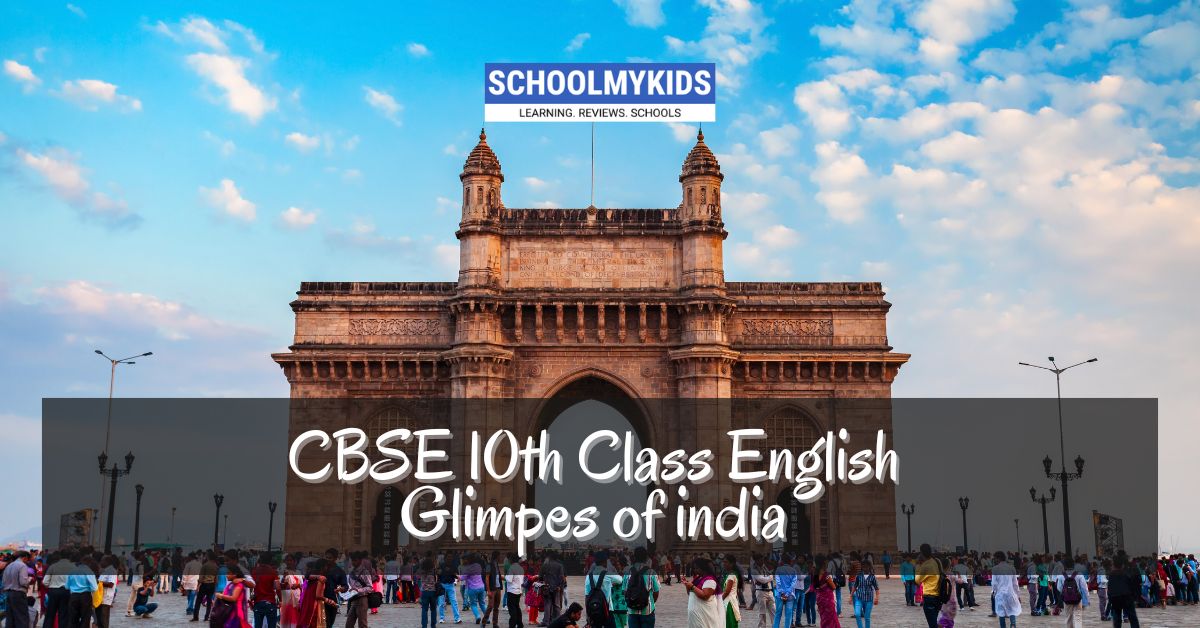“Glimpses of India” is a chapter from the Class 10 CBSE English textbook, “First Flight.” “Glimpses of India” is a collection of three short stories included in your CBSE English textbook. Each story offers a unique perspective on Indian life and culture. Here’s a breakdown of each story and its key points:
Story 1: A Baker from Goa (by Ruskin Bond)
- Setting: A small village in Goa, India.
- Characters:
- The narrator: Recalls his childhood memories of the baker (pader).
- The pader: A traditional Goan baker who visits the village twice a day selling bread.
- Summary: The story revolves around the narrator’s childhood memories of the baker, a familiar figure in their Goan village. The baker used a bamboo stick to announce his arrival, creating a distinctive jingle. He sold various types of bread, which were an essential part of Goan meals. The story highlights the warmth of village life and the importance of traditional occupations.
Story 2: Coorg (by R.K. Narayan)
- Setting: Coorg, a hilly district in southern India.
- Characters:
- The narrator: Visits Coorg and describes his impressions of the region.
- The people of Coorg: Known for their martial traditions, hospitality, and coffee plantations.
- Summary: This story offers a glimpse into the Coorg district, known for its breathtaking natural beauty, coffee plantations, and the distinct culture of its people. The narrator describes the Coorgs’ history, their martial traditions, and their warm hospitality. The story emphasizes the rich diversity of cultures within India.
Story 3: Tea from Assam (by Ajit Cour)
- Setting: A tea estate in Assam, a state in northeastern India.
- Characters:
- The narrator: A visitor to the tea estate, learning about the tea-making process.
- The workers: Employed in various stages of tea production.
- Summary: This story focuses on the tea industry in Assam. The narrator describes the process of tea cultivation, plucking, processing, and packaging. The story sheds light on the dedication of the workers and the economic significance of tea production in India.
Overall Significance for CBSE English
- These stories provide students with a glimpse into the diverse cultures, traditions, and landscapes of India.
- They showcase the importance of traditional occupations, the beauty of nature, and the dedication of people involved in various industries within India.
- The stories promote appreciation for cultural diversity and a sense of national identity.
- They can be used for analysis of literary devices, language style, and character portrayal.
Additional Points
- Each story offers a unique narrative voice and perspective.
- Analyzing the stories can lead to discussions about the importance of preserving traditions and the impact of economic activities on people’s lives.
20 Questions and Answers on “Glimpses of India” (CBSE English Focus)
Story 1: A Baker from Goa (Q1-Q5):
- Who is the narrator in “A Baker from Goa”?
- Answer: The narrator is someone who recalls their childhood memories of a baker in a Goan village.
- How did the baker announce his arrival in the village?
- Answer: The baker used a bamboo stick to create a distinctive jingle.
- What types of bread did the baker sell?
- Answer: The story mentions various types of bread, suggesting they were a staple food in the village.
- What aspect of Indian life does “A Baker from Goa” highlight?
- Answer: The story emphasizes the warmth of village life and the importance of traditional occupations like baking.
- Can you identify any literary devices used in the story?
- Answer: The story might use descriptive language to portray the sights and smells associated with the baker’s bread.
Story 2: Coorg (Q6-Q10):
- Where is Coorg located in India?
- Answer: Coorg is a hilly district situated in southern India.
- What are some of the things Coorg is known for?
- Answer: The story mentions Coorg’s natural beauty, coffee plantations, and the unique culture of its people.
- What is the historical background of the Coorgs mentioned in the story?
- Answer: The story might briefly touch upon the Coorgs’ martial traditions.
- How does “Coorg” contribute to the theme of diversity in “Glimpses of India”?
- Answer: The story showcases the rich cultural tapestry of India and the distinct traditions found in different regions.
- What kind of language might be used in the story to describe Coorg’s natural beauty?
- Answer: The story might use vivid imagery and descriptive language to paint a picture of Coorg’s landscapes.
Story 3: Tea from Assam (Q11-Q15):
- What is the setting of “Tea from Assam”?
- Answer: The story takes place on a tea estate in the northeastern Indian state of Assam.
- What does the narrator learn in the story?
- Answer: The narrator gains insight into the various stages of tea production, from cultivation to packaging.
- Who are the characters involved in the tea-making process mentioned in the story?
- Answer: The story might mention workers involved in plucking, processing, and packaging the tea leaves.
- What is the significance of the tea industry in India, as highlighted in the story?
- Answer: The story sheds light on the economic importance of tea production and the dedication of the workers involved.
- Can you identify a theme explored in “Tea from Assam” that connects to the other stories?
- Answer: Similar to “A Baker from Goa,” this story emphasizes the importance of traditional occupations and their contribution to the Indian economy.
Analysis and Appreciation (Q16-Q20):
- How do the three stories in “Glimpses of India” provide a diverse perspective on Indian life?
- Answer: Each story focuses on a different region, showcasing the cultural variations and economic activities within India.
- What message does “Glimpses of India” convey about the importance of preserving traditions?
- Answer: The stories might highlight the value of traditional occupations and cultural practices in shaping Indian identity.
- How can analyzing the language used in each story enhance your understanding?
- Answer: Examining the language choices can reveal the author’s style and the mood they aim to create.
- What discussions can “Glimpses of India” spark about the relationship between nature and human life in India?
- Answer: The stories might provide opportunities to discuss the impact of natural resources like tea plantations on people’s lives.
- In your opinion, how does “Glimpses of India” contribute to your understanding of India as a nation?
- Answer: The stories offer a glimpse into the diverse landscapes, cultures, and economic activities that define India.








Be the first one to comment on this story.